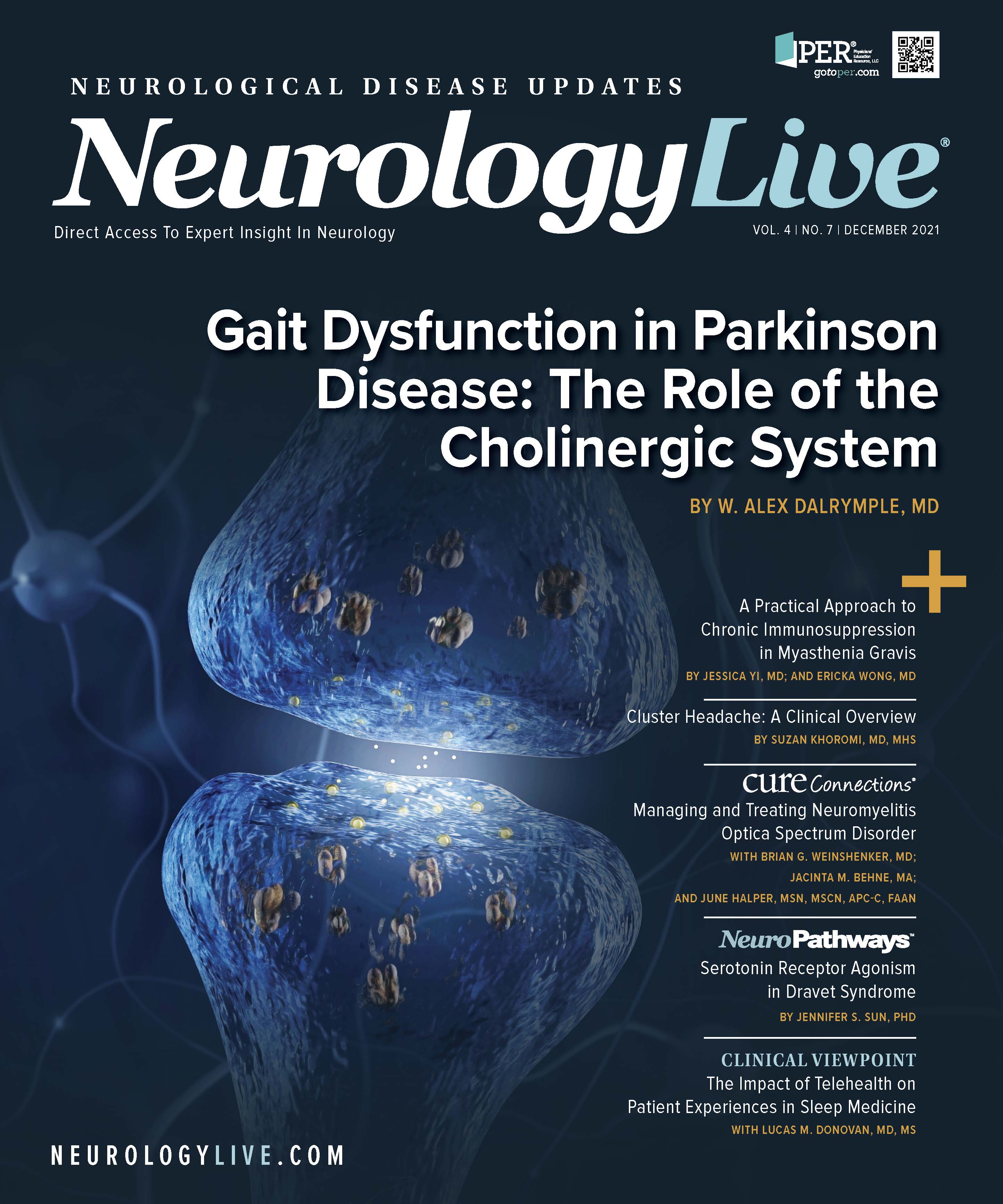News
Article
NeurologyLive
Managing and Treating Neuromyelitis Optica Spectrum Disorder
Author(s):
An expert neurologist, advocacy director, and a pair of patients with NMOSD discuss the current landscape of the demyelinating disorder.
Left to right: June Halper, MSN, APN-C, MSCN, FAAN; Brian G. Weinshenker, MD; Jacinta M. Behne, MA

NEUROMYELITIS OPTICA SPECTRUM DISORDER (NMOSD) is an inflammatory autoimmune condition of the central nervous (CNS) that affects the optic nerves and spinal cord. For many years it was not understood to be a standalone disorder and often was misdiagnosed as multiple sclerosis (MS). But over the past 2 decades, advances in the field of demyelinating disease have led to historically fast progress in the care of patients with NMOSD, and in the past 5 years those advances have resulted in 3 FDA-approved treatments.
NMOSD is distinct from MS mainly in the severity of its associated attacks and its somewhat selective nature of target as well as its prevalence. Although MS affects between 1 in 500 and 1 in 1000 individuals, NMOSD affects approximately 1 in 20,000 individuals. NMOSD usually is diagnosed with the identification of an immunoglobulin antibody directed against aquaporin-4.
In the recent NeurologyLive® CURE Connections® series “Managing Neuromyelitis Optica Spectrum Disorders (NMOSD),” a group of individuals from assorted backgrounds—including a physician, an advocacy director, and a pair of patients with the disorder—were brought together in conversation with June Halper, MSN, APN-C, MSCN, FAAN, a certified adult nurse practitioner specializing in MS and CEO of the Consortium of Multiple Sclerosis Centers. Halper inquired about the current state of care for NMOSD and moderated the discussion of varying aspects of treatment, with the patients offering their perspectives and sharing their experiences with the disease.
Treating NMOSD During COVID-19
The COVID-19 pandemic has affected the care of patients across the spectrum of disease. Halper asked Brian G. Weinshenker, MD, a consultant neurologist and a professor of neurology at Mayo Clinic, in Rochester, Minnesota, how COVID-19 has changed NMOSD care.
“The question is, what does NMO do to COVID-19, and [what does] the treatment for NMO do to COVID-19, and also does COVID-19 have any effects directly on NMO?” Weinshenker asked. “We generally would suggest [patients get] any COVID-19 vaccines or other vaccines because some of these drugs, such as inebilizumab [Uplizna; Horizon Therapeutics], can make patients very prone to another bacterial infection called meningococcus. We generally want vaccines to be administered before patients start on these treatments. Drugs such as inebilizumab, because it blocks the antibody response, likely would cause some impairment in the vaccine response if given afterward, although it’s likely there would be significant immunity. We encourage all patients with neuromyelitis optica to get the COVID-19 vaccine.”
Weinshenker noted that in recent months, data from studies in Italy and France have suggested that these patients do not face an increased risk of severe COVID-19 infection or mortality from COVID-19. This, he noted, was good news, as many patients take rituximab (Rituxan; Genentech/Biogen) or other therapies that deplete B cells.
“The evidence suggests that there’s minimal, if any, increased risk of getting severe COVID-19 or dying by virtue of being on these treatments. Generally, we recommend that patients with NMO continue on their NMO treatments and don’t stop them because of fears that they may make COVID-19 worse,” Weinshenker said.
Kim, a patient who had received a diagnosis of NMOSD fairly recently, explained to the group that COVID-19 has certainly influenced her conversations with her doctor. She explained that after getting her first vaccination dose, there was hesitancy about her getting the second and final dose over concerns it might trigger disease activity or relapse.
“We’re going to revisit that this week with my doctor because of everything that’s coming out,” she explained. “I have been especially careful, double masking and everything, and watching my little circle and keeping within my circle of people and knowing that they’re vaccinated. We do what we can to stay safe.”
Navigating NMOSD Infusion-Based Treatment
For patients who have just received a diagnosis of NMOSD, the treatment process can be challenging. Although NMOSD has been differentiated from MS, there can be misdiagnoses and confusion over the complexity of the disease and its treatments. Kim told the group that her journey has been packed with information.
“I’d felt something in my chest like a sharp pain as well as some other burning here. I had gone to an urgent care first, and I had also had a stomachache,” she said of her experience at disease onset. “I was sent home [after being told], ‘Oh, just take some medication for constipation.’ That doctor dismissed my symptoms. Within 1 more day, I went to [a different] urgent care, and I’m so happy that I was able to go to [one at] the best hospital. Right away they ran tests and eventually, [when I received the] diagnosis of NMO, I first received the plasma exchange, which was nerve-wracking.”
Kim explained that she is taking rituximab, and in her first 5 months there has been no recurrence or relapse. “I do feel pain every day because of the spasms, but as far as the relapses—none. I’m due next month in September to have another infusion. I didn’t have any problems before, so it’s just a little bit of a longer time. It does take sometimes between 4 and 6 hours,” she said.
For Doug, another patient with NMOSD, the treatment process was also a little daunting. He explained that he was treated with rituximab and concurrent corticosteroids while undergoing inpatient physical therapy. “Honestly, one of the scariest things of this whole process was when they had to put a jugular device in my neck. That’s a little uncomfortable to have that happen, and I actually had to have it done twice. The actual plex, or the plasmapheresis, for me was not too bad,” he said.
Doug explained that although his experience on rituximab was good because it prevented relapse, he was hospitalized every 4 to 6 weeks with an opportunistic infection, though he now undergoes monthly doses of immunoglobulins to prevent them. Overall, though, his patient journey has been a difficult one.
“I had to learn to walk all over again. I still don’t walk very well. The left side of my body is still pretty numb,” he explained. “I used to play the guitar and the piano, and I just don’t have the dexterity to do that. The plasmapheresis made a difference for me. The steroids didn’t seem to affect me at all, so I’m grateful that Dr Weinshenker developed that process because it made a difference in my life. I likely would be in much worse shape now without that.”
NMOSD Research Programs
The first FDA-approved therapy for NMOSD was a terminal complement inhibitor, eculizumab (Soliris; Alexion), which received approval in 2019. Since, 2 others have joined the treatment paradigm: inebilizumab, a B-cell depleting antibody therapy, and satralizumab (Enspryng; Genentech), an interleukin-6 receptor blocker. Before then, however, patients faced perhaps an even tougher journey with the disease, although advocacy groups pushed for more research. One such group, the Guthy-Jackson Charitable Foundation in Beverly Hills, California, has worked tirelessly to improve the lives of patients.
“We have funded a tremendous body of research, which has resulted in a body of high-impact papers in leading journals. Why? Because we knew that the research had to happen to best help our patient community,” Jacinta M. Behne, MA, executive director of the Guthy-Jackson Charitable Foundation, said. “When I say we’re a research foundation, we’re really a patient-centric foundation learning that we had to help these patients when there were no therapeutics on the shelf.”
Behne described the years of effort to get the pharmaceutical industry involved in the development of therapies for NMOSD, after watching as therapies with potential that could have been repurposed for the condition sat untouched on the shelf. All they needed, Behne said, was to convince 1 company to conduct a clinical trial.
“We made the argument that NMO could be a steppingstone to learning more about MS and other autoimmune diseases. Fortunately, at that time, we began working with the FDA. We knew that they were going to want to support clinical trials,” Behne said. CIRCLES, the first major study from the group, started in 2013 and ended in 2020 after collecting 7 years of patient data and blood specimens from 850 individuals with NMO. Now, she added, the group is embarking on a new study, SPHERES (NCT04886492).
“The thing about SPHERES is that we’re working with an organization called CorEvitas. It’s a registry that is accustomed to working with regulatory studies. The end of the trials that have just happened and the therapeutics that just went on the shelf need to pass another phase from the FDA of scrutiny. How safe are they? That’s what SPHERES is all about,” she said.
Although the research is important to Behne and the foundation, she explained that they are also interested in investing in patient quality of life. The Relapse Navigator tool helps patients identify and track their disease activity. Behne noted it is being developed in conjunction with Weinshenker and Dean Wingerchuk, MD, director of the Mayo Clinic Division of Multiple Sclerosis and Autoimmune Neurology, and is still being validated.
“When it’s finally rolled out for all, it’s a tool that will help clinicians adjudicate a relapse. It’s a tremendous instrument, and we’re very grateful for our neurologists for helping this along,” Behne said.
View the entire series, “Managing Neuromyelitis Optica Spectrum Disorders (NMOSD),” here: neurologylive.com/nmosd




